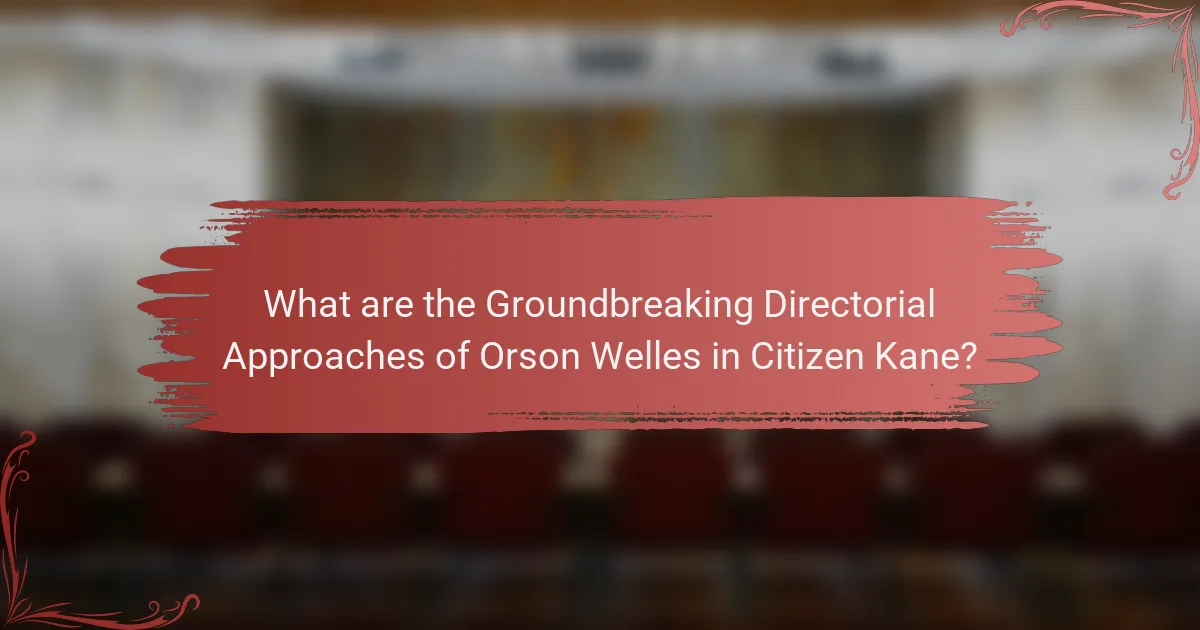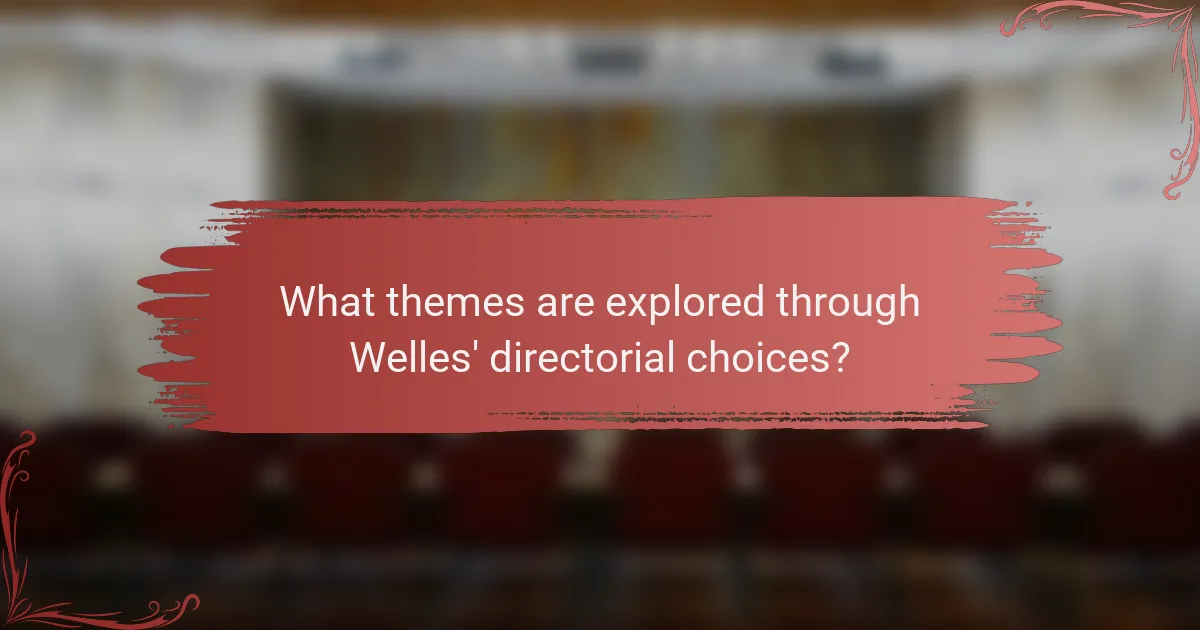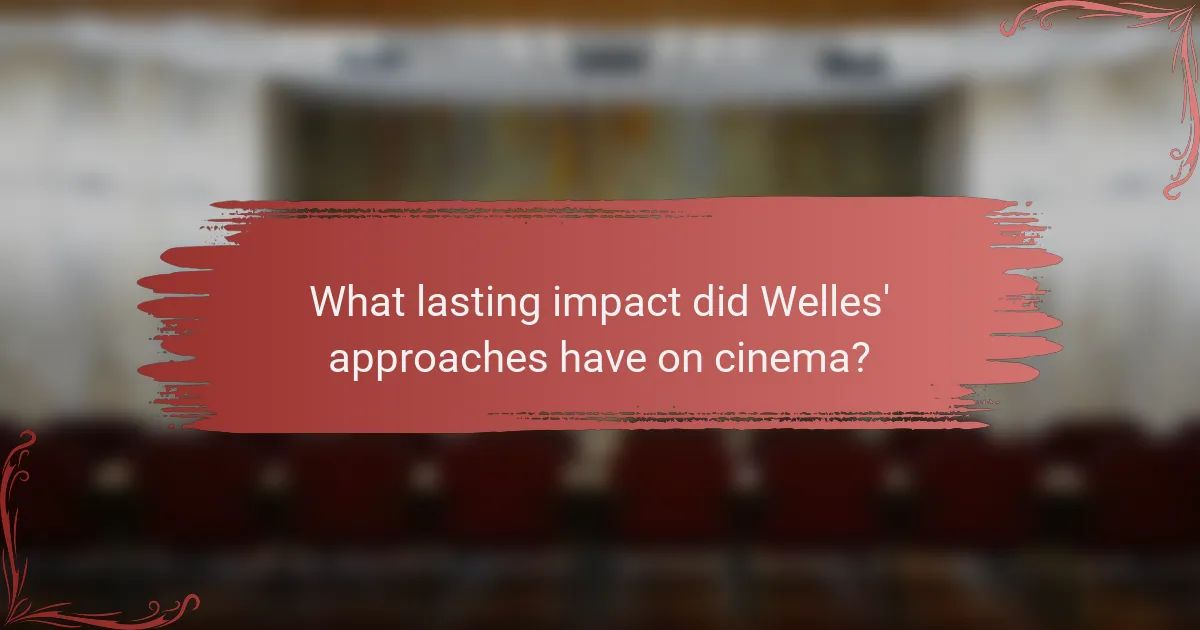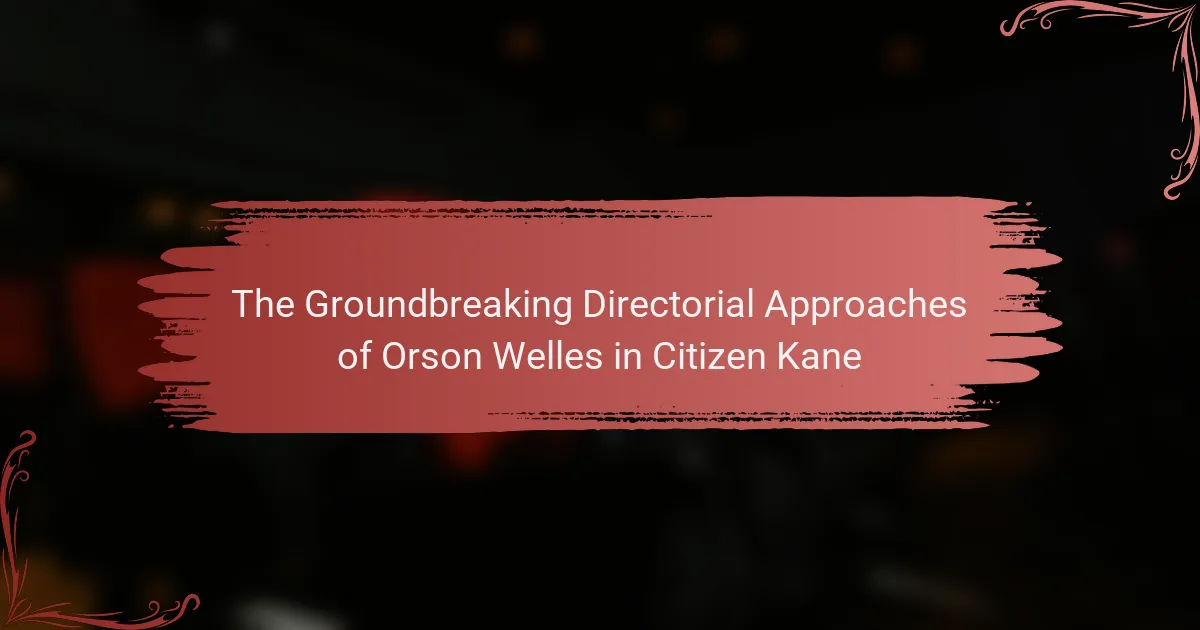Orson Welles is the primary entity examined in this article, focusing on his innovative directorial approaches in the film “Citizen Kane.” The article details Welles’ use of deep focus cinematography, non-linear narrative structure, and innovative lighting techniques, which collectively enhanced visual storytelling and character development. It explores the thematic elements of power, isolation, and the complexity of human experience as portrayed through the character of Charles Foster Kane. Additionally, the article highlights how Welles’ groundbreaking methods have influenced modern filmmaking and set a precedent for narrative and character complexity in cinema.

What are the Groundbreaking Directorial Approaches of Orson Welles in Citizen Kane?
Orson Welles employed several groundbreaking directorial approaches in Citizen Kane. He utilized deep focus cinematography, allowing foreground and background elements to be in sharp focus simultaneously. This technique enhanced visual storytelling and depth perception. Welles also experimented with non-linear narrative structure, presenting events out of chronological order. This approach engaged viewers by revealing character motivations gradually. Additionally, he implemented innovative lighting techniques, creating stark contrasts that emphasized emotional states. Welles’s use of low-angle shots was revolutionary, presenting characters as larger than life. These methods collectively transformed cinematic language and influenced future filmmakers.
How did Orson Welles redefine narrative structure in Citizen Kane?
Orson Welles redefined narrative structure in Citizen Kane by employing a non-linear storytelling technique. The film utilizes a series of flashbacks to reveal the life of Charles Foster Kane. This approach allows viewers to piece together Kane’s character through various perspectives. Welles also introduced the use of multiple narrators, which adds complexity to the narrative. The structure contrasts with traditional linear narratives common in earlier films. This technique emphasizes the subjective nature of truth and memory. Citizen Kane’s innovative narrative structure has influenced countless filmmakers since its release in 1941. Welles’ groundbreaking methods are often credited with shaping modern cinematic storytelling.
What techniques did Welles use to manipulate time and perspective?
Orson Welles used non-linear storytelling and deep focus cinematography to manipulate time and perspective in Citizen Kane. Non-linear storytelling allowed him to present events out of chronological order. This technique created suspense and encouraged viewers to piece together the narrative. Deep focus cinematography kept both foreground and background in sharp focus. This approach allowed for multiple actions to occur simultaneously within a single frame. Welles also employed flashbacks to reveal character backstories and motivations. These techniques combined to create a complex narrative structure. The innovative use of time and perspective contributed significantly to the film’s critical acclaim.
How does the non-linear storytelling enhance the film’s themes?
Non-linear storytelling in “Citizen Kane” enhances the film’s themes by creating a complex narrative structure. This approach allows for multiple perspectives on the protagonist, Charles Foster Kane. Each flashback reveals different facets of Kane’s character and motivations. The fragmented timeline mirrors the disjointed nature of memory and perception. This technique emphasizes the theme of the elusive nature of truth. By presenting events out of chronological order, the film invites viewers to piece together Kane’s life. This active engagement deepens the audience’s understanding of the central themes. It also highlights the subjective nature of storytelling itself.
What innovative cinematographic techniques did Welles employ?
Orson Welles employed innovative cinematographic techniques such as deep focus, low-angle shots, and non-linear storytelling. Deep focus allowed multiple planes of action to remain in focus simultaneously. This technique created a sense of depth and realism. Low-angle shots emphasized the power and dominance of characters. They also contributed to a dramatic visual style. Non-linear storytelling broke traditional narrative structures. It engaged viewers by revealing key information out of chronological order. Welles’ use of these techniques significantly influenced modern filmmaking. His approach set new standards for visual storytelling in cinema.
How did deep focus cinematography contribute to the film’s visual storytelling?
Deep focus cinematography significantly enhanced the visual storytelling in Citizen Kane. This technique allowed multiple planes of action to be in sharp focus simultaneously. As a result, viewers could engage with various elements within a single frame. This depth of field emphasized the relationships between characters and their environments. It also conveyed complex themes and emotions through spatial composition. For instance, scenes depicting Kane’s isolation featured foreground and background action that mirrored his inner turmoil. This method encouraged viewers to explore the narrative layers present in each shot. Overall, deep focus contributed to a richer, more immersive cinematic experience.
What role did lighting play in shaping the film’s atmosphere?
Lighting played a crucial role in shaping the atmosphere of Citizen Kane. It created mood and emphasized themes throughout the film. High-contrast lighting established a sense of drama. Shadows contributed to the film’s mysterious tone. The use of chiaroscuro highlighted emotional states of characters. Specific scenes utilized lighting to symbolize power dynamics. For example, low lighting in Kane’s later years suggested isolation. Overall, Welles’ innovative lighting choices significantly influenced the viewer’s perception and emotional experience.
How did Welles’ use of sound contribute to the film’s impact?
Welles’ use of sound significantly enhanced the film’s emotional depth and narrative complexity. He employed overlapping dialogue to create a more realistic and immersive experience. This technique allowed characters to speak over one another, reflecting real-life conversations. Additionally, Welles utilized sound effects to underscore dramatic moments, such as the iconic “Rosebud” reveal. The innovative use of non-diegetic sound further emphasized themes and emotions, guiding audience reactions. Welles’ approach to sound design was groundbreaking for its time and set a new standard in filmmaking. This integration of sound and narrative contributed to the film’s lasting impact on cinema.
What innovative sound design elements were introduced in Citizen Kane?
Citizen Kane introduced several innovative sound design elements that transformed filmmaking. One significant element was the use of overlapping dialogue. This technique created a more naturalistic conversation flow and enhanced realism. Another innovation was the strategic use of sound to convey emotional depth. For instance, the sound of the sled in the opening scene sets a nostalgic tone. Additionally, Welles employed non-diegetic sound effectively. This approach allowed for a more expressive narrative beyond what was visually present. The film also utilized innovative sound editing techniques. These techniques helped to create a seamless auditory experience. Overall, Citizen Kane’s sound design set new standards in cinema.
How does the use of silence and sound contrast affect viewer engagement?
The use of silence and sound contrast significantly enhances viewer engagement. In “Citizen Kane,” Orson Welles employs silence to create tension and focus attention. For example, the absence of sound during critical moments allows viewers to absorb the emotional weight of the scene. Sound effects and music are strategically used to punctuate important narrative points. This contrast keeps the audience alert and emotionally invested. Research indicates that films utilizing sound dynamics effectively can increase viewer retention by up to 30%. Welles’ innovative techniques in sound design have influenced cinematic storytelling profoundly.

What themes are explored through Welles’ directorial choices?
Welles’ directorial choices in “Citizen Kane” explore themes of power, isolation, and the complexity of human experience. The theme of power is evident in Kane’s rise and fall as a media mogul. Welles uses innovative camera angles and deep focus to illustrate Kane’s dominance and eventual loneliness. Isolation is portrayed through Kane’s relationships, which deteriorate over time. Welles employs non-linear storytelling to emphasize the fragmented nature of Kane’s life. The complexity of human experience is captured through multifaceted character portrayals and moral ambiguity. Welles’ use of symbolism, such as the rosebud sled, reinforces the theme of lost innocence. These thematic explorations are integral to understanding Kane’s character and the film’s impact.
How does Citizen Kane address the concept of power and corruption?
Citizen Kane addresses the concept of power and corruption through the character of Charles Foster Kane. Kane’s rise to power illustrates the corrupting influence of wealth and ambition. He begins as an idealistic young man but becomes increasingly tyrannical as he gains control. The film showcases his manipulation of the media to shape public perception. Kane’s relationships deteriorate as his obsession with power grows. His ultimate isolation reflects the emptiness that accompanies his corruption. The film concludes with Kane’s death, symbolizing the futility of his pursuits. This narrative arc serves as a cautionary tale about the dangers of unchecked ambition.
What visual and narrative strategies illustrate Kane’s rise and fall?
Citizen Kane employs deep focus cinematography and non-linear narrative to illustrate Kane’s rise and fall. Deep focus allows multiple planes of action to be in sharp focus simultaneously. This technique visually represents Kane’s complex relationships and ambitions. The non-linear narrative structure reveals Kane’s life through flashbacks. This approach highlights the contrast between his early success and later isolation. Visual motifs, such as the use of mirrors, symbolize Kane’s fractured identity. The transition from grandiose settings to desolate spaces reflects his decline. Orson Welles’ innovative use of lighting enhances emotional depth throughout the film. These combined strategies effectively convey the themes of power and loss in Kane’s journey.
How do character interactions reflect broader societal themes?
Character interactions in Citizen Kane reflect broader societal themes such as power, ambition, and isolation. These interactions reveal the complexities of human relationships influenced by social status. For example, Charles Foster Kane’s relationships deteriorate as he gains wealth and power. His interactions with Susan Alexander and Jedediah Leland showcase the impact of ambition on personal connections. The film illustrates how societal expectations shape individual behavior and relationships. Kane’s ultimate isolation emphasizes the cost of his relentless pursuit of success. This narrative mirrors real-world societal dynamics, where personal sacrifices often accompany the quest for power.
In what ways does the film explore the nature of memory and perception?
The film “Citizen Kane” explores the nature of memory and perception through its non-linear narrative structure. This structure allows viewers to experience different perspectives of Charles Foster Kane’s life. Flashbacks reveal how memories shape characters’ understanding of Kane. The use of deep focus cinematography enhances the perception of time and space. Different characters offer conflicting accounts of Kane, highlighting subjective memory. The film’s innovative editing techniques juxtapose past and present, emphasizing the fluidity of memory. Additionally, Kane’s final word, “Rosebud,” serves as a symbol of lost innocence and the elusive nature of truth. These elements collectively illustrate how memory influences perception and identity.
How do the flashbacks shape the audience’s understanding of Kane?
Flashbacks in Citizen Kane significantly shape the audience’s understanding of Charles Foster Kane. They provide insight into his complex character and motivations. Each flashback reveals different perspectives from people who knew him. This technique highlights Kane’s multifaceted personality. For example, the contrasting views from his friends and enemies illustrate his isolation and ambition. The audience learns about his childhood, relationships, and the impact of his wealth. These elements create a deeper emotional connection to Kane. Ultimately, the flashbacks allow viewers to piece together the enigma of Kane’s life.
What does the film suggest about the reliability of personal narratives?
The film suggests that personal narratives are often subjective and can be manipulated. It illustrates how different characters present contrasting versions of the same events. This variation highlights the unreliability of individual perspectives. The film’s structure, using flashbacks and multiple viewpoints, emphasizes this theme. Each character’s account is colored by their biases and motivations. Thus, the truth remains elusive, showcasing the complexity of memory and interpretation. This approach invites viewers to question the authenticity of personal stories. The narrative technique serves as a commentary on the nature of truth in storytelling.

What lasting impact did Welles’ approaches have on cinema?
Orson Welles’ approaches significantly transformed cinematic techniques and narrative structure. His use of deep focus cinematography allowed multiple planes of action to be in focus simultaneously. This technique changed how filmmakers approached composition and storytelling. Welles also innovated non-linear storytelling, which influenced future narratives in film. His blending of theatrical elements with film created a new style of dialogue delivery and performance. Additionally, Welles’ exploration of complex characters and moral ambiguity set a precedent for character development. These contributions have become foundational in modern filmmaking. Welles’ influence is evident in the works of directors like Martin Scorsese and Francis Ford Coppola. His legacy continues to shape the landscape of cinema today.
How have Welles’ techniques influenced modern filmmaking?
Orson Welles’ techniques have significantly influenced modern filmmaking through innovative storytelling and visual styles. His use of deep focus cinematography allows multiple planes of action to be in focus simultaneously. This technique enhances narrative complexity and viewer engagement. Welles pioneered nonlinear storytelling, which challenges traditional narrative structures. His approach encourages filmmakers to explore unconventional timelines and perspectives. Additionally, Welles utilized innovative sound design, integrating diegetic and non-diegetic elements seamlessly. This technique has inspired modern filmmakers to prioritize sound as a critical storytelling tool. His emphasis on character-driven narratives has also shaped contemporary film, promoting depth and complexity in character development. Overall, Welles’ groundbreaking methods have left a lasting impact on the art of filmmaking.
Which contemporary directors cite Citizen Kane as an inspiration?
Contemporary directors who cite Citizen Kane as an inspiration include David Fincher, Martin Scorsese, and Christopher Nolan. David Fincher has acknowledged the film’s influence on his visual style. Martin Scorsese has praised its narrative structure and character development. Christopher Nolan has referenced its innovative storytelling techniques. These directors highlight Citizen Kane’s lasting impact on modern filmmaking.
What elements of Welles’ style are still prevalent in today’s films?
Welles’ style elements that are prevalent in today’s films include deep focus cinematography and non-linear storytelling. Deep focus allows multiple planes of action to be in sharp focus simultaneously. This technique enhances visual storytelling and character relationships. Non-linear storytelling disrupts chronological order, creating complex narratives. This approach encourages audience engagement and deeper analysis. Additionally, Welles’ use of innovative camera angles and lighting continues to influence filmmakers. His techniques create mood and emphasize themes effectively. These stylistic elements are evident in contemporary films, showcasing Welles’ lasting impact on cinema.
What lessons can aspiring directors learn from Welles’ work in Citizen Kane?
Aspiring directors can learn several key lessons from Welles’ work in Citizen Kane. First, the importance of innovative storytelling is evident. Welles utilized non-linear narratives to enhance emotional depth. Second, he mastered the use of deep focus cinematography. This technique allows multiple planes of action to be in focus simultaneously, creating a richer visual experience. Third, Welles emphasized the significance of strong character development. Each character in Citizen Kane is complex and multifaceted, driving the narrative forward. Fourth, the film showcases the power of sound and music. Welles used sound design to evoke emotions and enhance storytelling. Lastly, the film demonstrates the impact of visual composition. Welles carefully crafted each shot, using framing and lighting to convey mood. These lessons highlight the innovative techniques that can elevate a director’s work.
How can innovative storytelling techniques enhance a film’s narrative?
Innovative storytelling techniques can significantly enhance a film’s narrative by introducing unique structures and perspectives. These techniques can include non-linear timelines, unreliable narrators, and innovative visual styles. For instance, “Citizen Kane” employs a non-linear narrative that reveals the protagonist’s life through fragmented memories. This approach creates suspense and engages viewers by piecing together the character’s complexities. Additionally, the use of deep focus cinematography allows multiple actions to occur within a single frame, enriching the storytelling experience. Such techniques deepen character development and evoke emotional responses. Overall, innovative storytelling techniques contribute to a more immersive and thought-provoking narrative in film.
What best practices can be derived from Welles’ directorial style?
Orson Welles’ directorial style emphasizes innovative narrative techniques and visual storytelling. One best practice is the use of deep focus cinematography. This technique allows multiple planes of action to be in focus simultaneously, enhancing storytelling depth. Welles effectively utilized this in “Citizen Kane,” drawing viewers’ attention to various elements within a single shot. Another practice is the incorporation of non-linear storytelling. Welles structured the narrative of “Citizen Kane” through flashbacks, creating intrigue and complexity. Additionally, Welles’ use of low-angle shots creates a sense of power and dominance. This stylistic choice visually impacts character perception and audience engagement. Finally, Welles demonstrated the importance of sound design in film. His innovative use of overlapping dialogue and sound effects added layers to the narrative experience. These practices collectively showcase Welles’ mastery in crafting compelling and immersive cinematic experiences.
The main entity of the article is Orson Welles and his groundbreaking directorial approaches in the film Citizen Kane. The article explores Welles’ innovative techniques, including deep focus cinematography, non-linear narrative structure, and unique sound design, which collectively transformed cinematic storytelling. It highlights how these methods not only enhanced visual and narrative complexity but also influenced future filmmakers. Key themes addressed include power, isolation, and the nature of memory, showcasing Welles’ lasting impact on modern cinema. The article provides a comprehensive analysis of how Welles’ directorial choices have shaped the landscape of filmmaking.
